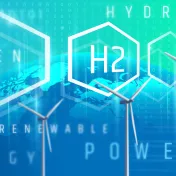In its coalition agreement, the German government has set itself the goal of expanding offshore wind energy to 70 GW by 2045. This target is polarising. On the one hand, offshore wind energy has a high number of full load hours and can thus make a reliable contribution to decarbonisation. On the other hand, the expansion of 70 GW of offshore wind energy is very likely to increase the need for grid expansion, raise issues of marine protection and bring challenges such as the timely availability of resources.
In the various “System visions” (Systemvisionen), the assessments of actors involved assessments regarding the future expansion of offshore wind energy also diverge significantly. In this article we want to address the question of where these differences lie in the assessment of offshore wind energy and show which measures can support the development of compromises and mitigate conflicting goals.
- Positions in the debate
1.1 What are the positive effects of 70 GW of offshore wind energy?
In order to achieve climate targets, a rapid replacement of conventional power plants by renewable energies is necessary. According to German Federal Minister for Economic Affairs and Climate Action Robert Habeck, offshore wind energy is to play a major role in this (BMWK, 2021). Compared to onshore and photovoltaics, offshore wind energy has the advantage that it achieves higher full-load hours and still reliably generates electricity even at times of low onshore wind energy production. In particular, it enables both the decarbonisation of industry and the supply of metropolitan areas with comparatively little planning effort.
Compared to onshore, the expansion of offshore wind energy involves a smaller number of mostly institutionally-involved actors. In the case of onshore wind energy, actors’ reservations can contribute to delays in the planning and permission processes. The focus on offshore wind energy thus reduces the pressure on onshore conflicts. For the decarbonisation of industry, a large amount of green hydrogen is needed in addition to the renewable electricity mentioned above. Electrolysers should also have a high number of full-load hours in order for amortisation to be assured. Thus, the coupling of offshore wind energy and electrolysers is a good idea. Another advantage is that if the hydrogen is already produced at sea or on the coast, the infrastructure only has to be expanded for the amount of energy that is actually used in the end (minus some minor transport losses). If, on the other hand, hydrogen were to be produced close to consumption sites, the electricity grid infrastructure would also have to be expanded for the transmission of electricity which is ultimately lost due to the high efficiency losses during electrolysis of approx. 18 - 33 % (Milanzi et al, 2018).
Due to Russia's war of aggression on Ukraine, which violates international law, another dimension must be integrated into the considerations: Renewable energies must be expanded even more urgently in order to reduce dependence on fossil energy imports.
1.2 What are the negative effects of 70 GW of offshore wind energy?
The oceans are in a very poor condition, which endangers biodiversity, but also the effect of the natural CO2 sink: they are overfished, polluted and increasingly acidified (Heinrich Böll Foundation, 2017). To halt the global biodiversity crisis and enable effective climate protection, the marine environment must be restored to a better state. However, wind turbines and their connection to land initially represent a further intervention in the marine environment.
Conflicts of use also arise with other actors at sea such as fisheries, the navy and shipping: according to studies, the maximum areas currently available in the North Sea and Baltic Sea respectively offer space for 57 GW (Fraunhofer, 2017) and 60 GW of offshore wind energy (Deutsche WindGuard, 2021). To increase this potential, areas would have to be shared or freed up from other forms of use in favour of wind energy.
With the increased use of wind energy offshore, the demand for expansion of the electricity is very likely to rise. The surplus of energy demand , especially in the south and west of Germany, if satisfied by offshore wind energy rather than regional expansion of onshore wind energy, will also increase needs for electricity transmission.
- Options for action
Designing a climate-neutral energy system involves conflicting goals. In the various “System visions”, these conflicting goals also become clear with regard to the expansion of offshore wind energy: Do we want to focus on avoiding conflicts related to species protection or land use rather on land or at sea? What proportion of hydrogen should be produced domestically, taking account the need for more space this entails? What proportion of hydrogen should be imported - knowing full well that this will shift spatial requirements abroad, raise questions about socially just supply chains and create new import dependencies with regimes whose reliability may also be dubious? As different as the positions here may be - there is also broad agreement on a fundamental need to accelerate the expansion of photovoltaics, onshore wind energy and offshore wind energy.We would now like to present some measures that can mitigate the conflicts and thus help to identify common ground and develop compromises. We must find solutions to conflicts now to avoid delays in achieving climate protection goals.
2.1 Strengthen European cooperation
The expansion of offshore wind energy and the strengthening of nature conservation at sea are European tasks. In order to proceed as efficiently as possible and in a manner that is compatible with nature, joint spatial planning is advantageous. For example, if areas for wind farms are planned jointly with the countries bordering the respective sea, the amount of energy generated can be increased. In addition, marine protection can be improved if nature conservation areas are implemented across borders. At the European level, measures could be defined that aim to improve the condition of the seas and compensate for the impacts of the infrastructure built. Efforts should be made to adapt the framework conditions, for example by better harmonising spatial planning at the European level or by facilitating the cross-border planning of wind farms.
2.2 Discuss interdependencies of offshore wind energy
An important basis for finding a compromise is to consider the interdependencies in the energy system: if demand for offshore wind energy is to be reduced, then options must be developed that close this gap. A first building block in the development of compromises is energy saving. Measures which significantly reduce demand offer the potential to reduce the overall amount of wind energy offshore required. Another component is the achievement of targets for the expansion of onshore wind energy and photovoltaics. If this expansion can be accelerated in such a way to provide confidence that targets will be exceeded, then compromises can be developed. Storage and demand flexibility also offer potential to shift demand from the more CO2-intensive generation periods, to those where renewables are generating surpluses.
2.3 Scientific monitoring
To ensure that the impact of wind turbines on the state of the oceans is assessed by a neutral body, scientific monitoring must be introduced. This should include monitoring of nature conservation concerns and the development of compensatory measures. The expansion of offshore wind energy is a technical and organisational challenge, caused by the limited availability of resources (wind turbines, personnel, ships, etc.), the timing of the connection of the offshore wind farm to the onshore energy system, and the risk of having to retrieve maritime weapons. Again, scientific monitoring is advised to monitor progress and delays to ultimately ensure that climate targets are met. In addition, mechanisms must be provided to allow for readjustments as soon as monitoring findings suggest that this is necessary.
2.4 Integrated planning of energy infrastructure
In the course of decarbonisation, the demand for electricity, but also for hydrogen, will increase. In the case of offshore wind energy, a trade-off must be made between the transmission of electricity and the transport of hydrogen, which could be produced directly at sea or at the point of landfall. This decision must be well weighed up in terms of electricity and hydrogen demand, conversion losses and the dimensioning of the infrastructure. In this way, infrastructure expansion can be designed more efficiently and thus as environmentally compatible as possible. Electricity and gas grid planning must be integrated: A system development plan that precedes the expansion plans for the electricity, gas and heating sectors could enable more coherent energy supply planning.
- Conclusion
In order to achieve climate protection goals, the speed of renewable energy expansion in Germany must be massively increased. Conflicting goals must be mitigated for offshore wind energy as well as for onshore wind energy and photovoltaics.
It must be possible to work out and implement compromises together, as well as to allow for readjustments that make sense from an overall system perspective and those which emerge through monitoring. For this, path dependencies must be identified and discussed. For example, it could make sense to consider modular elements in planning that keep various options open, such as for a successful common European network-approach. So long as the expansion is accompanied by scientific and democratic monitoring, nothing stands in the way of starting the planning and acceleration.
This article was created for Amprion's "Systemvision 2050" project and first published in German on www.systemvision2050.de.



